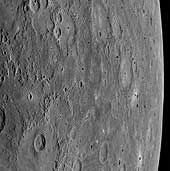|
COMETS EARTH JUPITER KUIPER BELT MARS MERCURY METEORITES NEPTUNE OORT CLOUD PLUTO SATURN SOLAR SYSTEM SPACE SUN URANUS VENUS ORDER PRINTS
PHOTO CATEGORIES SCIENCEVIEWS AMERICAN INDIAN AMPHIBIANS BIRDS BUGS FINE ART FOSSILS THE ISLANDS HISTORICAL PHOTOS MAMMALS OTHER PARKS PLANTS RELIGIOUS REPTILES SCIENCEVIEWS PRINTS
|
Related Documents
Download Options
ust nine minutes after the MESSENGER spacecraft passed 200 kilometers (124 miles) above the surface of Mercury, its closest distance to the planet during the January 14, 2008, flyby, the Wide Angle Camera (WAC) on the Mercury Dual Imaging System (MDIS) snapped this image. The WAC is equipped with 11 different narrow-band filters, and this image was taken in filter 7, which is sensitive to light near the red end of the visible spectrum (750 nm). This view, also imaged through the remaining 10 WAC filters, is from the first set of images taken following MESSENGER's closest approach with Mercury. The image shows Mercury's surface as seen from a low viewing angle, looking over the surface and off the limb of the planet on the right side of the image. The cratered terrain in the image is on the side of Mercury unseen by spacecraft prior to this MESSENGER flyby. This scene was imaged at multiple viewing angles as MESSENGER sped away from Mercury, and these multiple views of the same surface features from different perspectives and in different colors will be used to help understand the properties of Mercury's surface. Credit: NASA/Johns Hopkins University Applied Physics Laboratory/Carnegie Institution of Washington |
